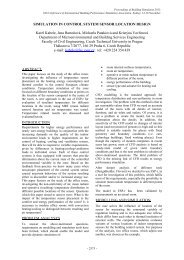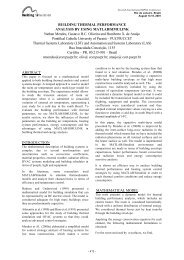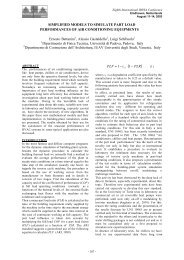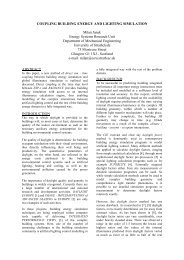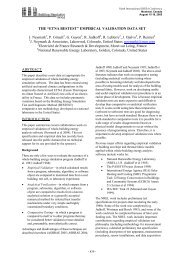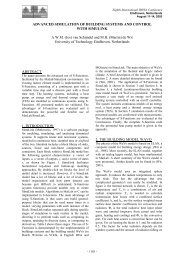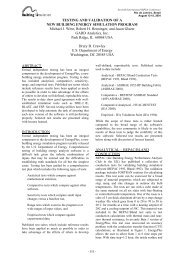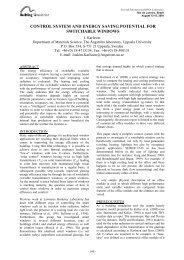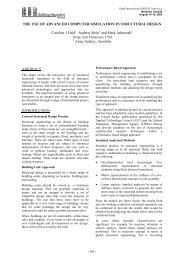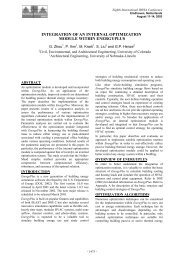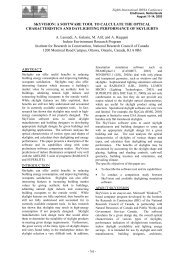numerical simulation of buildings thermal behaviour and ... - ibpsa
numerical simulation of buildings thermal behaviour and ... - ibpsa
numerical simulation of buildings thermal behaviour and ... - ibpsa
You also want an ePaper? Increase the reach of your titles
YUMPU automatically turns print PDFs into web optimized ePapers that Google loves.
lightly higher in the body right side than in the<br />
left side. Nevertheless, this asymmetry is not very<br />
significant;<br />
- the occupant seated in the desk near the window<br />
is subjected to direct solar radiation in the head,<br />
neck, chest <strong>and</strong> upper members. In the abdomen<br />
<strong>and</strong> inferior members the solar radiation is<br />
shading by the desk;<br />
- in accord to ISO 7730 (1994), the occupant<br />
seated near the window is <strong>thermal</strong>ly<br />
uncomfortable. Nevertheless, when he is far from<br />
the window, not subjected to solar radiation, he is<br />
in <strong>thermal</strong> comfort conditions.<br />
CONCLUSIONS<br />
In this work two <strong>numerical</strong> models, that evaluate<br />
respectively the <strong>buildings</strong> <strong>thermal</strong> <strong>behaviour</strong> <strong>and</strong> the<br />
human <strong>thermal</strong> comfort, were presented. The first<br />
one was used in the <strong>thermal</strong> study <strong>of</strong> a building, with<br />
two floors, located in the South <strong>of</strong> Portugal in a<br />
Winter day with clean sky. The second one was used<br />
in the evaluation <strong>of</strong> <strong>thermal</strong> comfort level that an<br />
occupant is subjected, when he is seated in a<br />
compartment with a window turned towards West.<br />
It was verified that at 16 p.m., when the occupant is<br />
seated near the window, uncomfortable conditions<br />
were obtained. Nevertheless, if the occupant is not<br />
subjected to direct solar radiation, the comfort<br />
<strong>thermal</strong> conditions are obtained.<br />
These models, in collaboration, can be used to<br />
develop <strong>buildings</strong> <strong>thermal</strong>ly efficient with optimised<br />
<strong>thermal</strong> comfort levels. They are a very important<br />
tool to be used not only in the study <strong>of</strong> special<br />
compartments, like <strong>of</strong>fices, classrooms <strong>and</strong> atria, for<br />
example, where is important to create good comfort<br />
conditions for seated occupants, but also in the<br />
project <strong>of</strong> localised heating, ventilation, air<br />
conditioning <strong>and</strong> radiant panel systems, in nonuniform<br />
environments.<br />
In this work was not analysed the local discomfort<br />
level. This topic will be done in future studies. The<br />
building <strong>thermal</strong> <strong>behaviour</strong> model, in the near future<br />
research, will be subjected to more experimental tests<br />
in <strong>buildings</strong> with complex topology.<br />
ACKNOWLEDGEMENT<br />
The author acknowledges the support by<br />
INOVALGARVE program, CCR-Alg <strong>and</strong><br />
DREALG, sponsored by the European comunitary<br />
fund FEDER.<br />
Part <strong>of</strong> this research activity is also being developed<br />
inside a project approved <strong>and</strong> financed by the FCT<br />
- 233 -<br />
<strong>and</strong> POCTI, sponsored by the European comunitary<br />
fund FEDER.<br />
REFERENCES<br />
ASHRAE H<strong>and</strong>book, “Fundamentals”, American<br />
Society <strong>of</strong> Heating, Refrigerating <strong>and</strong> Air-<br />
Conditioning Engineers, Inc., Atlanta, USA, 2001.<br />
Berne, Ph., “Prediction <strong>of</strong> the Concentration Decay<br />
in a Ventilated Enclosure by the Multi-zone Model”,<br />
RoomVent 1994 - 4th Int. Conference on Air<br />
Distribution in Rooms, Kraków, Pol<strong>and</strong>, 1994.<br />
Burden, R. L. <strong>and</strong> Faires, J. D., “Numerical<br />
Analysis”, Prindle, Weber & Schmidt, Boston, USA,<br />
1985.<br />
Cammarata, G.; Fichera, A.; Forgia. F.; Marletta, L.<br />
<strong>and</strong> Muscato, G., “Thermal Load Buildings General<br />
Models <strong>and</strong> Reduce Models”, Healthy Buildings<br />
1994, Proc. <strong>of</strong> the 3 rd Int. Conference, Budapest,<br />
Hungary, 1994.<br />
Conceição, E. Z. E. <strong>and</strong> Lúcio, Mª M. J. R.,<br />
“Influence <strong>of</strong> Non-Uniform Airflow from Different<br />
Directions in the Thermal Comfort Level in Seated<br />
Persons”, RoomVent 2002 - 8th Int Conference on<br />
Air Distribution in Rooms, Copenhagen, Denmark,<br />
2002<br />
Conceição, E. Z. E. <strong>and</strong> Lúcio, Mª M. J. R.,<br />
“Numerical <strong>and</strong> Subjective Responses <strong>of</strong> Human<br />
Thermal Sensation”, BioEng 2001, 6 th Portuguese<br />
Conference on Biomedical Engeering, University <strong>of</strong><br />
Algarve, Faro, Portugal, 2001.<br />
Conceição, E. Z. E., “Evaluation <strong>of</strong> Thermal Comfort<br />
<strong>and</strong> Local Discomfort Conditions Using the<br />
Numerical Modelling <strong>of</strong> the Human <strong>and</strong> Clothing<br />
Thermal System”, RoomVent 2000 - 7 th Int.<br />
Conference on Air Distribution in Rooms, University<br />
<strong>of</strong> Reading, United Kingdom, 2000.<br />
Conceição, E. Z. E., “Geração de Malha em Torno de<br />
Ocupantes em Compartimentos com Topologia<br />
Complexa”, VII Congresso de Mecânia Aplicada e<br />
Computacional, University <strong>of</strong> Évora, Évora,<br />
Portugal, 2003.<br />
Conceição, E. Z. E., “Multi-nodal Models <strong>of</strong><br />
Vehicles Thermal Behaviour <strong>and</strong> Passenger Thermal<br />
Response”, Florence ATA 2001 - 7th Int.<br />
Conference, Florence, Italy, 2001.<br />
Corrado, C.; Pretti, M. <strong>and</strong> Sacchi, A. “Routine for<br />
Calculation <strong>of</strong> Angle Factors Between Human Body<br />
<strong>and</strong> Car Driver’s Cabin”, Proc. ATA Congress,<br />
Bologne, Italy, 1995.



